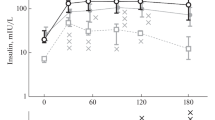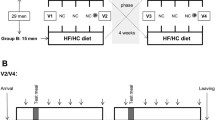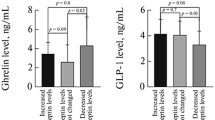Blood levels of glucose and immunoreactive insulin were assessed in women with android and gynoid types of obesity or normal body weight (control group) in the dynamics of oral glucose tolerance test in the morning and in the evening. In the control group, the mean concentrations of glucose and immunoreactive insulin were significantly higher in the evening at all test terms (0, 60 and 120 min), which is indicative of physiological insulin resistance in the evening. In the group of women with gynoid obesity, no difference in the levels of glucose and immunoreactive insulin was revealed in the morning and evening tests, but in the evening tests, glucose (60 and 120 min) and immunoreactive insulin (120 min) levels were lower than in the control group. In the group of women with android obesity, the evening glucose level on minutes 60 and 120 of the test was higher than in the morning, but immunoreactive insulin did not vary throughout the day and on minutes 60 and 120 it surpassed the corresponding parameter in the control group by 2-4 times. In case of gynoid obesity, glucose load was followed by hyperinsulinemia and hypoglycemia; in android obesity, it was followed by hyperinsulinemia, hyperglycemia, and insulin resistance irrespective of the time of the day.
Similar content being viewed by others
References
Pinchasov BB, Astrakhantseva EL, Shorin YP, Kogay MA, Selyatitskaya VG. Individual reactivity features of female organism with different type of obesity on nutrition deprivation. Sib. Nauch. Med. Zh. 2009; 29(3):115-121. Russian.
Selyatitskaya VG, Pinkhasov BB, Karapetyan AR, Kuzminova OI. Adipokines and a risk for metabolic disturbances in different types of female obesity. Ter. Arkhiv. 2015; (10):80-84. Russian.
Butler AE, Janson J, Bonner-Weir S, Ritzel R, Rizza RA, Butler PC. Beta-cell deficit and increased beta-cell apoptosis in humans with type 2 diabetes. Diabetes. 2003; 52(1):102-10.
Van Cauter E., Blackman J.D., Roland D., Spire J.P., Refetoff S., Polonsky K.S. Modulation of glucose regulation and insulin secretion by circadian rhythmicity and sleep. J Clin Invest. 1991; 88(3): 934-942. doi: 10.1172/JCI115396.
Froy O. The circadian clock and metabolism. Clin Sci (Lond). 2011; 120(2):65-72. doi: 10.1042/CS20100327.
Gonnissen HK, Hulshof T, Westerterp-Plantenga MS. Chronobiology, endocrinology, and energy- and food-reward homeostasis. Obes Rev. 2013; 14(5):405-16. doi: 10.1111/obr.12019.
Pinkhasov BB, Selyatitskaya VG, Karapetyan AR, Astrakhantseva EL. Metabolic syndrome in men and women with upper or lower types of body fat distribution. Health. 2012; 4(12A):1381-1389.
Prasai MJ, George JT, Scott EM. Molecular clocks, type 2 diabetes and cardiovascular disease. Diab Vasc Dis Res. 2008; 5(2):89-95. doi: 10.3132/dvdr.2008.015.
Seo MH, Rhee EJ. Metabolic and cardiovascular implications of a metabolically healthy obesity phenotype. Endocrinol Metab (Seoul). 2014 29; 29(4):427-34. doi: 10.3803/EnM.2014.29.4.427.
Takeda N, Maemura K. Circadian clock and cardiovascular disease. J Cardiol. 2011; 57(3):249-56. doi: 10.1016/j.jjcc.2011.02.006.
Williams EP, Mesidor M, Winters K, Dubbert PM, Wyatt SB. Overweight and obesity: prevalence, consequences, and causes of a growing public health problem. Am J Med Sci. 2006; 331(4):166-74.
Young ME, Bray MS. Potential role for peripheral circadian clock dyssynchrony in the pathogenesis of cardiovascular dysfunction. Sleep Med. 2007; 8(6): 656-667.
Author information
Authors and Affiliations
Corresponding author
Additional information
Translated from Byulleten’ Eksperimental’noi Biologii i Meditsiny, Vol. 161, No. 3, pp. 296-299, March, 2016
Rights and permissions
About this article
Cite this article
Pinkhasov, B.B., Selyatinskaya, V.G., Astrakhantseva, E.L. et al. Circadian Rhythms of Carbohydrate Metabolism in Women with Different Types of Obesity. Bull Exp Biol Med 161, 323–326 (2016). https://doi.org/10.1007/s10517-016-3406-2
Received:
Published:
Issue Date:
DOI: https://doi.org/10.1007/s10517-016-3406-2




